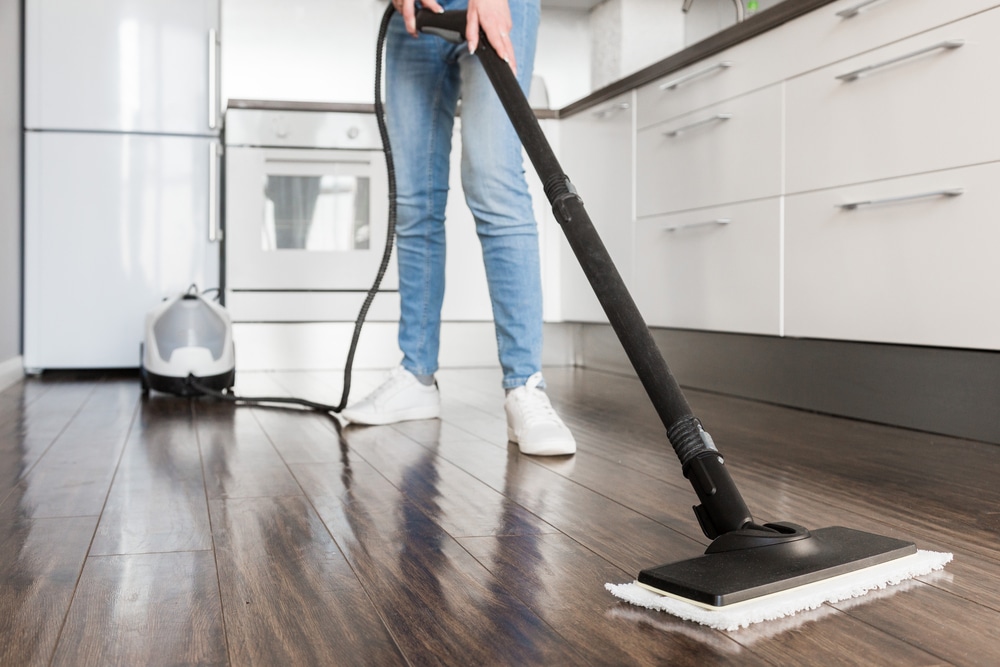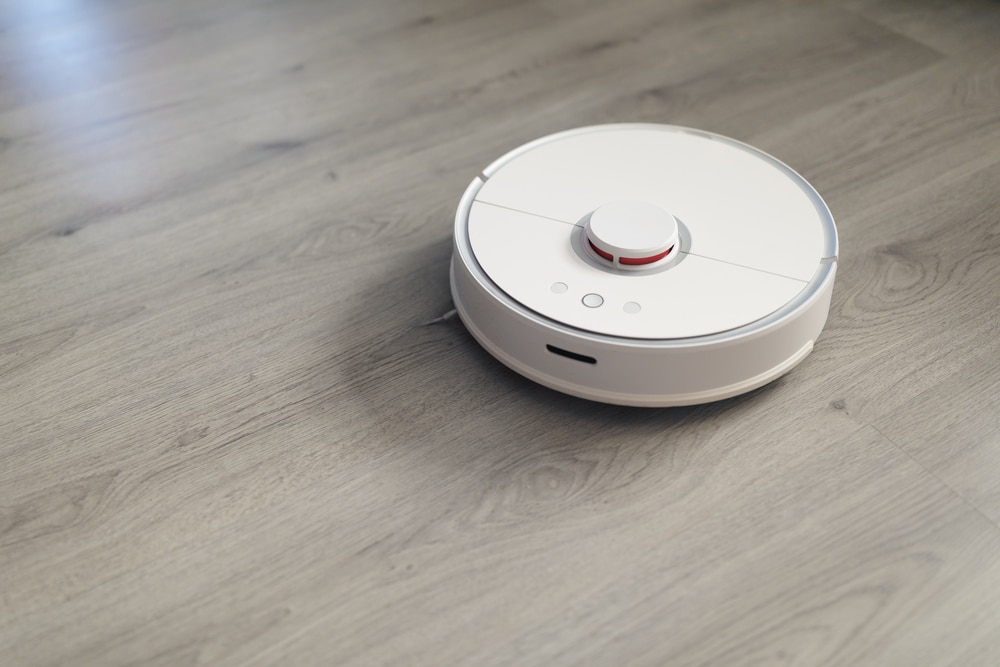Last Updated on
Steam mops easily kill bacteria and remove grime that builds up on your floor and is significantly easier to use than a traditional mop. Of course, regular maintenance and preventative care are necessary to maintain a steam mop functioning as effectively as possible, just like with other machines or appliances.
If the water tank on your steam mop starts to develop a cloudy appearance or the steam output decreases, descaling your steam mop will most likely prevent it from becoming clogged. Descaling your steam mop can also improve functionality overall.
This article will teach you how to descale a steam mop using six easy steps. It also explores some helpful pro tips that will keep your steam mops running smoothly for a long time to come.
Why Should You Descale Your Steam Mop?
With steam mops, mineral deposits in your tap water can easily adhere to the internal surfaces of the water tank and the spray nozzle. These hard water minerals and limescale can build up inside your steam cleaner and leave a cloudy residue. They can also clog the spray tips leading to poor steam production, and coat the heating elements of steam cleaners.
Every few months, descale steam mops or steam cleaners as part of regular maintenance to enhance performance and extend the lifespan of your machine as a whole. Descaling your steam cleaner will help get rid of mineral deposits, ensuring maximum steam output.
Can You Put Vinegar In Your Steam Mop?
Most steam cleaner manufacturers strongly recommend against putting anything other than water inside the reservoir. With this in mind, is it okay to put vinegar or other cleaning agents in your steam cleaner? Yes. However, you should not do it frequently, and you should always dilute the cleaner first.
Vinegar contains a mild acid that can break down limescale, so a little vinegar diluted with water is generally thought of as an acceptable cleaner for use in your steam mops. Just make sure you don’t use a professional descaling product with chemicals or any other type of cleaner that contains harsh chemicals.
Descaling Your Steam Cleaning Mop: 6 Easy Steps
Step 1: Prepare Your Tools and Cleaning Agent

When it comes to cleaning and descaling your steam mop, you won’t need much. You may even have the supplies at home.
You can choose several cleaning agents when it comes to descaling the water reservoir on your steam cleaner. Just make sure not to use a cleaner that contains harsh chemicals, like bleach, as they could damage your machine.
Cleaning Agents to Choose From
- White vinegar and water
- Baking soda and water
- Dri-Pak Soda Crystals, liquid soap, and hot water
Tools You Will Need
- Distilled water (optional but recommended over tap water)
- Cotton Swabs
- Large paperclip
- Clean cloth or paper towels
- Bucket to mix the cleaning solution
- Screwdriver (may be needed to remove the mop head base plate)
Step 2: Fill the Water Tank With Your Preferred Cleaning Agent
Before you start cleaning and descaling your steam cleaner, make sure to turn it off and remove the plug from the socket. Some steam cleaners automatically heat up when plugged into mains power. Hence, making sure to unplug the unit is an important safety precaution.
When ready, unscrew the cap on your steam mop’s water tank and add your preferred cleaning agent up to the maximum fill line. Take care not to overfill the tank, as it could prevent pressure from building up correctly later in the descaling process.
White Vinegar
If you are using white vinegar as your cleaner, mix a solution of 2 parts water and 1 part vinegar. This will prevent the acid present in vinegar from potentially damaging the water tank on your unit.
Baking Soda
If you choose to use baking soda, mix 1.5 ounces with 1 quart of water and stir the solution thoroughly.
Dri Pak Soda Crystals
If you choose to use Dri Pak Soda Crystals, you will want to follow the directions on the package to dilute them correctly. Make a mild or weak solution and add a teaspoon or less liquid soap as well. Mix thoroughly.
Step 3: Leave the Water Tank to Soak
Reseal the water reservoir and leave the cleaning solution to soak. We recommend leaving the water tank of your steamer to sit for at least an hour but leaving it for longer is often quite helpful. If you are using white vinegar or baking soda, let the steamer sit for 5 hours or overnight to get the best results. This amount of time may be a bit excessive with soda crystals.
Step 4: Steam Until the Tank Is Empty
After you let the cleaning solution soak, turn on your steam cleaner to the highest heat and steam setting. Wait about a minute so it has time to heat up, and then press the trigger on your mop’s handle while aiming it away from your skin or the floor. Continue pressing the button until the reservoir of your steam cleaner is empty.
Step 5: Refill Tank With Clean Water and Steam Again
Next, fill the water tank with clean, distilled water. Repeat the steaming process until all the water in the tank is gone. This will help rinse out the interior and remove any leftover cleaning solution from the steam holes of your steam cleaner.
Step 6: Clean the Steam Outlet Holes
For the final step, you will want to clean out the steam holes and wipe down the mop head. Insert a large paperclip into the output hole and wiggle it around. You may need to unscrew the mop head base plate to access the steam tip, but this varies from one steam cleaner to the next. Follow this up by rubbing a cotton swab dipped in vinegar around the hole as well. Lastly, give the mop a final wipe-down, and your system is all set to start steam cleaning again.
How to Reduce Build-up
The following tips will help you use your steam mop to the best of its ability and also reduce the rate at which build-up occurs.
- Do not use fabric softeners or dryer sheets when you wash steam mop pads. A fabric softener on the mop head can clog the nozzle and reduce the pads’ ability to absorb moisture. We recommend you air-dry your mop clothes.
- Don’t use water softeners, as they can leave an additional residue.
- Before you use your steam mop, always take the time to vacuum or sweep your floors. This will eliminate larger pieces of dirt and debris that could potentially clog the steam outlet holes.
- Read the user manual to learn about preventative maintenance recommendations and pro tips on your specific machine.
- Always wipe down the mop head and empty the water tank after each use. This will prevent mildew and keep the steam outlet holes clean until the next time you descale it.
Caring For Your Steam Mop Made Easy
After reading through our article on how to descale a steam mop, caring for your investment should be easy if you follow the simple steps listed above. If you use your steam cleaner frequently, we recommend cleaning it once every six weeks to get the best results. However, if you only put distilled water in the tank, you may do it once every couple of months. Just remember to avoid harsh chemicals, and you should do great.
How often do you clean your steam mop? Let us know in the comments below.
Emily is a woman of many talents. She has a B.A. in English and enjoys writing. Emily loves accessorising her home with quality products that not only serve a purpose but also enhance the overall convenience and tranquillity of her living space; there’s nothing like coming home to your own personal sanctuary after a long day! She loves anything that can make life easier or more comfortable—from dishware to furniture to lighting fixtures.



